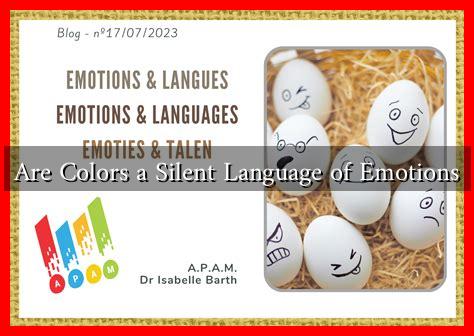-
Table of Contents
Are Colors a Silent Language of Emotions?
Colors have a profound impact on our emotions and perceptions, often acting as a silent language that communicates feelings without the need for words. From the vibrant hues of a sunset to the calming shades of blue in a room, colors can evoke a wide range of emotional responses. This article explores the intricate relationship between colors and emotions, supported by research, examples, and case studies.
The Psychology of Color
The study of how colors affect human behavior and emotions is known as color psychology. This field examines how different colors can influence our mood, decision-making, and even physiological responses. Here are some key findings:
- Red: Often associated with passion, love, and anger, red can increase heart rates and create a sense of urgency. It is frequently used in marketing to grab attention.
- Blue: Known for its calming effects, blue is often linked to tranquility and stability. Studies have shown that blue environments can lower heart rates and reduce anxiety.
- Yellow: This bright color is often associated with happiness and optimism. However, excessive yellow can lead to feelings of frustration and anger.
- Green: Symbolizing nature and growth, green is known to have a soothing effect and is often used in spaces designed for relaxation.
- Purple: Often associated with luxury and creativity, purple can evoke feelings of mystery and spirituality.
Case Studies and Real-World Applications
Numerous studies have demonstrated the impact of color on emotions in various settings. For instance, a study conducted by the University of British Columbia found that people exposed to the color red performed better on detail-oriented tasks, while those in blue environments excelled in creative tasks. This suggests that color can influence cognitive performance based on the emotional state it evokes.
In marketing, companies have long understood the power of color. A study by the Institute for Color Research found that color increases brand recognition by up to 80%. Brands like Coca-Cola use red to evoke excitement and energy, while Facebook employs blue to create a sense of trust and security. These strategic choices highlight how colors can communicate brand values and influence consumer behavior.
Colors in Art and Culture
Throughout history, colors have played a significant role in art and culture, often symbolizing deeper meanings and emotions. For example:
- In Western cultures: White is often associated with purity and innocence, commonly used in weddings.
- In Eastern cultures: White can symbolize mourning and death, showcasing how cultural context can alter the emotional interpretation of colors.
- In art: Artists like Vincent van Gogh used color to express emotions, with his use of vibrant yellows and blues reflecting his mental state.
Moreover, the use of color in therapy, known as color therapy or chromotherapy, is gaining traction. Practitioners believe that different colors can help heal emotional and physical ailments, further emphasizing the connection between color and emotional well-being.
The Science Behind Color Perception
Color perception is not just subjective; it is also rooted in science. The human eye can perceive millions of colors, and our brains interpret these colors based on various factors, including context, lighting, and personal experiences. Research has shown that our emotional responses to colors can be influenced by:
- Biological factors: Individual differences in vision and neurological responses can affect how we perceive colors.
- Cultural influences: Cultural background can shape our associations with specific colors, leading to varied emotional responses.
- Personal experiences: Past experiences can create unique emotional connections to certain colors.
Conclusion
Colors indeed serve as a silent language of emotions, influencing our feelings, behaviors, and perceptions in profound ways. From the calming effects of blue to the energizing impact of red, colors can evoke a spectrum of emotional responses that are both universal and culturally specific. Understanding the psychology of color can enhance our awareness of how we communicate and connect with others, whether in marketing, art, or everyday life.
As we continue to explore the intricate relationship between colors and emotions, it becomes clear that this silent language is a powerful tool for expression and connection. For further reading on the psychology of color, you can visit Color Psychology.

